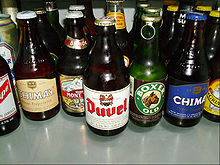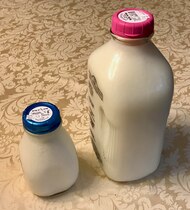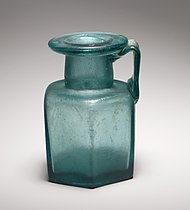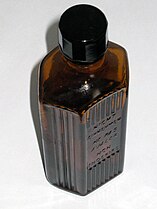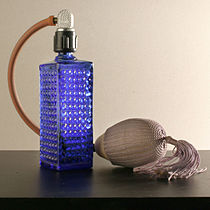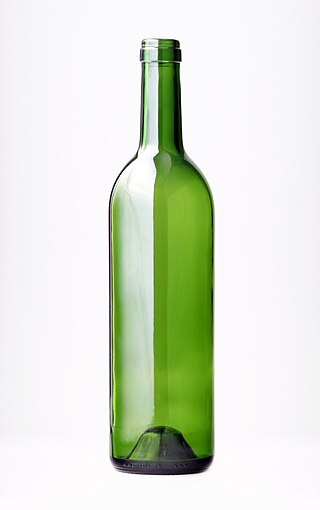
A bottle is a narrow-necked container made of an impermeable material in various shapes and sizes that stores and transports liquids. Its mouth, at the bottling line, can be sealed with an internal stopper, an external bottle cap, a closure, or induction sealing.
A screw cap or closure is a common type of closure for bottles, jars, and tubes.

Glassblowing is a glassforming technique that involves inflating molten glass into a bubble with the aid of a blowpipe. A person who blows glass is called a glassblower, glassmith, or gaffer. A lampworker manipulates glass with the use of a torch on a smaller scale, such as in producing precision laboratory glassware out of borosilicate glass.

A bottle cap or bottle top is a closure for the top opening of a bottle. A cap is sometimes colorfully decorated with the logo of the brand of contents. Plastic caps are used for plastic bottles, while metal with plastic backing is used for glass; plastic caps are commonly made from polyethylene or polypropylene, while metal caps are usually either steel or aluminum. Plastic caps may have a pour spout. Flip-Top caps like Flapper closures provide controlled dispensing of dry products. Caps for plastic bottles are often made of a different type of plastic from the bottle.

A jar is a rigid, cylindrical or slightly conical container, typically made of glass, ceramic, or plastic, with a wide mouth or opening that can be closed with a lid, screw cap, lug cap, cork stopper, roll-on cap, crimp-on cap, press-on cap, plastic shrink, heat sealed lidding film, an inner seal, a tamper-evident band, or other suitable means. The English word "jar" originates from the Arabic word jarra, which means an earthen pot or vessel.

A stopper, bung, or cork is a cylindrical or conical closure used to seal a container, such as a bottle, tube, or barrel.

A closure is a device used to close or seal a container such as a bottle, jug, jar, tube, or can. A closure may be a cap, cover, lid, plug, liner, or the like. The part of the container to which the closure is applied is called the finish.
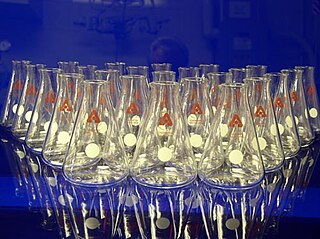
Laboratory flasks are vessels or containers that fall into the category of laboratory equipment known as glassware. In laboratory and other scientific settings, they are usually referred to simply as flasks. Flasks come in a number of shapes and a wide range of sizes, but a common distinguishing aspect in their shapes is a wider vessel "body" and one narrower tubular sections at the top called necks which have an opening at the top. Laboratory flask sizes are specified by the volume they can hold, typically in metric units such as milliliters or liters. Laboratory flasks have traditionally been made of glass, but can also be made of plastic.

Blow molding is a manufacturing process for forming hollow plastic parts. It is also used for forming glass bottles or other hollow shapes.
Wine accessories are things that may be used in the storage or serving of wine. Wine accessories include many items such as wine glasses, corkscrews, and wine racks.

Glass milk bottles are glass bottles used for milk. They are reusable and returnable – used mainly for doorstep delivery of fresh milk by milkmen. Once customers have finished the milk, empty bottles are expected to be rinsed and left on the doorstep for collection, or rinsed bottles may be returned to a participating retail store. Bottle sizes vary depending on region, but common sizes include pint, quart or litre.

A foundry is a factory that produces metal castings. Metals are cast into shapes by melting them into a liquid, pouring the metal into a mold, and removing the mold material after the metal has solidified as it cools. The most common metals processed are aluminum and cast iron. However, other metals, such as bronze, brass, steel, magnesium, and zinc, are also used to produce castings in foundries. In this process, parts of desired shapes and sizes can be formed.

A jug is a type of container commonly used to hold liquids. It has an opening, sometimes narrow, from which to pour or drink, and has a handle, and often a pouring lip. Jugs throughout history have been made of metal, ceramic, or glass, and plastic is now common.

Glass recycling is the processing of waste glass into usable products. Glass that is crushed or imploded and ready to be remelted is called cullet. There are two types of cullet: internal and external. Internal cullet is composed of defective products detected and rejected by a quality control process during the industrial process of glass manufacturing, transition phases of product changes and production offcuts. External cullet is waste glass that has been collected or reprocessed with the purpose of recycling. External cullet is classified as waste. The word "cullet", when used in the context of end-of-waste, will always refer to external cullet.
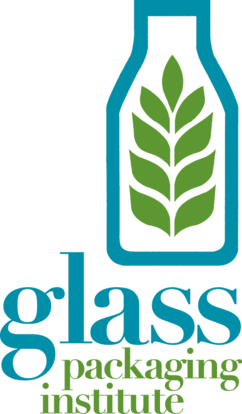
The Glass Packaging Institute (GPI) is the North American trade association for the glass container industry, headquartered in Arlington, Virginia. Through GPI, glass container manufacturers advocate job preservation and industry standards, and promote sound energy, environmental, and recycling policies.

A vial is a small glass or plastic vessel or bottle, often used to store medication in the form of liquids, powders, or capsules. They can also be used as scientific sample vessels; for instance, in autosampler devices in analytical chromatography. Vial-like glass containers date back to classical antiquity; modern vials are often made of plastics such as polypropylene. There are different types of vials such as a single dose vial and multi-dose vials often used for medications. The single dose vial is only used once whereas a multi-dose vial can be used more than once. The CDC sets specific guidelines on multi-dose vials.

Wine corks are a stopper used to seal wine bottles. They are typically made from cork, though synthetic materials can be used. Common alternative wine closures include screw caps and glass stoppers. 68 percent of all cork is produced for wine bottle stoppers.
Glass production involves two main methods – the float glass process that produces sheet glass, and glassblowing that produces bottles and other containers. It has been done in a variety of ways during the history of glass.

A container is any receptacle or enclosure for holding a product used in storage, packaging, and transportation, including shipping. Things kept inside of a container are protected on several sides by being inside of its structure. The term is most frequently applied to devices made from materials that are durable and are often partly or completely rigid.

